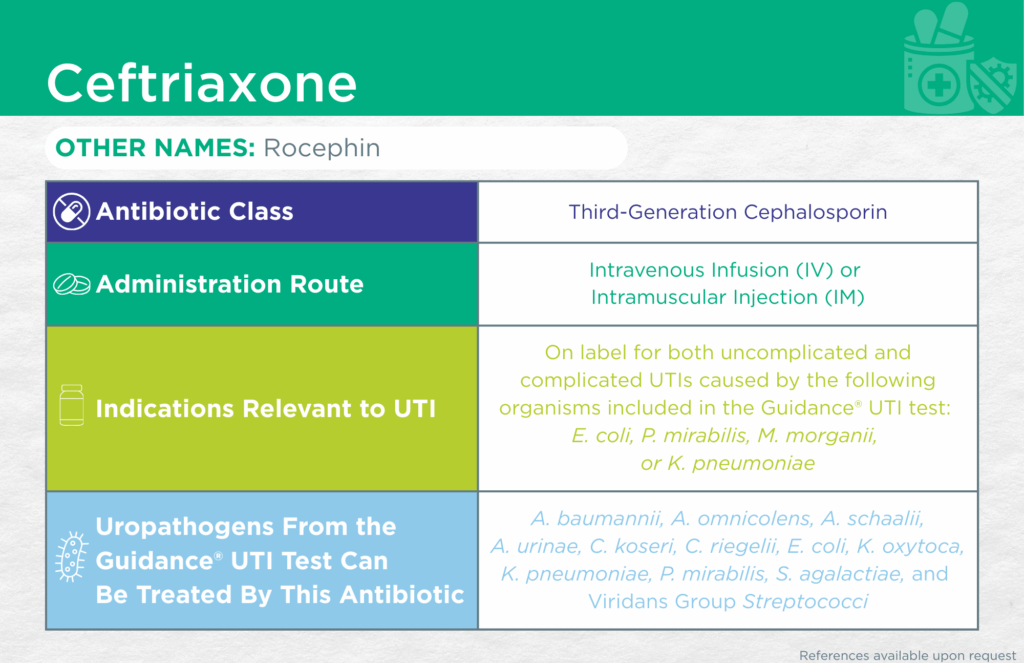Ceftriaxone

Emery Haley, PhD, Scientific Writing Specialist
Ceftazidime
Find the Latest FDA-Approved Labelling Information Here: Drugs@FDA Online Database
Administrative Routes
Parenteral [intravenous infusion (IV), intramuscular injection (IM)]
Other Names
Rocephin
Bacteriostatic or Bactericidal
Bactericidal [1]
Antibiotic Class
Third-Generation Cephalosporin
Mechanisms of Action
Ceftriaxone, a beta-lactam antibiotic, binds to penicillin-binding proteins (PBPs) on bacterial cell walls. PBPs are essential for the formation of peptidoglycan, which gives the bacterial wall strength and integrity. Binding of ceftriaxone to PBPs leads to failure of peptidoglycan cell wall synthesis, causing bacterial cell death.
WHO AWaRe Classification
Watch [2]
Empiric Use Recommendations
Yes (upper UTI/pyelonephritis) [World Health Organization (WHO)] [3]
Yes (preferred for complicated UTI with or without sepsis) [Infectious Diseases Society of America (IDSA)] [4]
Indication(s) Relevant to UTI
On label for both uncomplicated and complicated UTIs caused by the following organisms included in the Guidance® UTI test: Escherichia coli, Proteus mirabilis, Morganella morganii, or Klebsiella pneumoniae.
Checkmarks
CLSI and/or FDA documents support the efficacy of this antibiotic against the following organisms from the Guidance® UTI test: Acinetobacter baumannii, Aerococcus urinae, Citrobacter koseri, Corynebacterium riegelii, Escherichia coli, Klebsiella oxytoca, Klebsiella pneumoniae, Proteus mirabilis, Streptococcus agalactiae, and Viridans Group Streptococci.
Published primary literature supports the efficacy of this antibiotic against the following organisms from the Guidance® UTI test: Alloscardovia omnicolens [5] and Actinotignum schaalii [6-8]
- Ishak, A.; Mazonakis, N.; Spernovasilis, N.; Akinosoglou, K.; Tsioutis, C. Bactericidal versus Bacteriostatic Antibacterials: Clinical Significance, Differences and Synergistic Potential in Clinical Practice. J. Antimicrob. Chemother. 2024, 80, 1–17, doi:10.1093/jac/dkae380
- AWaRe Classification of Antibiotics for Evaluation and Monitoring of Use, 2023 Available online: https://www.who.int/publications/i/item/WHO-MHP-HPS-EML-2023.04 (accessed on 6 February 2025).
- The WHO AWaRe (Access, Watch, Reserve) Antibiotic Book – Infographics – PAHO/WHO | Pan American Health Organization Available online: https://www.paho.org/en/documents/who-aware-access-watch-reserve-antibiotic-book-infographics (accessed on 22 July 2025).
- Complicated Urinary Tract Infections (CUTI): Clinical Guidelines for Treatment and Management Available online: https://www.idsociety.org/practice-guideline/complicated-urinary-tract-infections/ (accessed on 28 July 2025).
- Isnard, C.; Lienhard, R.; Reissier, S.; Rodriguez, S.; Krähenbühl, J.; Liassine, N.; Guérin, F.; Cattoir, V. In Vitro Antimicrobial Susceptibility of Alloscardovia Omnicolens and Molecular Mechanisms of Acquired Resistance. Diagnostic Microbiology and Infectious Disease 2016, 84, 227–229, doi:10.1016/j.diagmicrobio.2015.08.009.
- Lotte, R.; Lotte, L.; Ruimy, R. Actinotignum Schaalii (Formerly Actinobaculum Schaalii): A Newly Recognized Pathogen—Review of the Literature. Clin Microbiol Infec 2016, 22, 28–36, doi:10.1016/j.cmi.2015.10.038.
- Beguelin, C.; Genne, D.; Varca, A.; Tritten, M. ‐L.; Siegrist, H.H.; Jaton, K.; Lienhard, R. Actinobaculum Schaalii: Clinical Observation of 20 Cases. Clin Microbiol Infec 2011, 17, 1027–1031, doi:10.1111/j.1469-0691.2010.03370.x.
- Cattoir, V.; Varca, A.; Greub, G.; Prod’hom, G.; Legrand, P.; Lienhard, R. In Vitro Susceptibility of Actinobaculum Schaalii to 12 Antimicrobial Agents and Molecular Analysis of Fluoroquinolone Resistance. J Antimicrob Chemoth 2010, 65, 2514–2517, doi:10.1093/jac/dkq383.
Dr. Emery Haley is a scientific writing specialist with over ten years of experience in translational cell and molecular biology. As both a former laboratory scientist and an experienced science communicator, Dr. Haley is passionate about making complex research clear, approachable, and relevant. Their work has been published in over 10 papers and focuses on bridging the gap between the lab and real-world patient care to help drive better health outcomes.